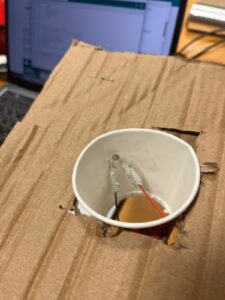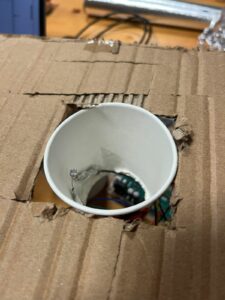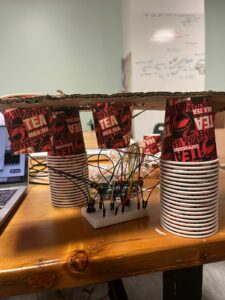Concept:
For this week, Izah and I decided to create a musical instrument based on our favorite analog sensor: the photoresistor. To do this, we decided to utilize an interesting concept to make the instrument work: an instrument that can only be played with 2 people. The idea here was to provide a completely different experience compared to traditional musical instruments. First of all, by allowing the notes only to be played with 3 hands and second, allowing to have different notes based purely on the placement of the hand (no touch). Because no traditional instrument requires 2 people to play it, we considered that this would be a greatly innovative idea.
Demonstration
Code highlight:
if (switchState ==1){
//sensor 1
if(sensorValue1 > 500){
currentState+=100;
}
else if (sensorValue1>250 && sensorValue1 < 500) {
currentState+=10;
}
else if (sensorValue1 < 250){
currentState+=1;
}
//sensor 2
if(sensorValue2 > 500){
currentState+=100;
}
else if (sensorValue2>250 && sensorValue2 < 500) {
currentState+=10;
}
else if (sensorValue2 < 250){
currentState+=1;
}
//sensor 3
if(sensorValue3 > 500){
currentState+=100;
}
else if (sensorValue3>250 && sensorValue3 < 500) {
currentState+=10;
}
else if (sensorValue3 < 250){
currentState+=1;
}
This code provides the change of currentState. Current State can be incremented in increments of 1, 10, or 100. This ensures that the state is always controlled in a way where we can always tell exactly in what level all sensors are working on. For example, if currentState = 111, then that means that there is one HIGH, one MID and one LOW state, regardless of which is which.
Challenges:
In this project, we faced multiple challenges that slowed down and hindered our development. For starters, because of the circuit that we built, being able to sustain the structure of the instrument was a big challenge we had to face. To solve this problem, we utilized a cardboard base, supported by the same paper cups we used to cover the light for the photoresistors.
Improvements:
In this case, the improvements would be related to polishing the implementation of the photoresistor detection. One of the biggest improvements we could apply would be to place all sensors at the same angle, in such a way that all of them captured the same light level initially. By doing this, the hand movements could be more streamlined and straightforward. Because we utilized
Another possible improvement would be to solder the photoresistors and the cables together in order to provide a more solid connection and avoid some connection problems that happen every once in a while.




